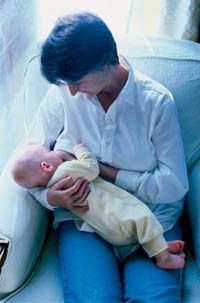Throughout your pregnancy, you probably imagined how wonderful the breast-feeding experience would be for both you and your baby. All you could think about was looking down into that tiny, trusting face and feeling the closeness between you and this new little being. So naturally, when it finally came time to put baby to breast, you were excited. But now, you're in agony. Your nipples may be painful, cracked, and bleeding. Or perhaps your breasts are uncomfortably swollen. The milk may not flow when you need it to and may seem to flow uncontrollably when you most wish it wouldn't (like when you're standing in line at the grocery store or sitting at a dinner party). So where are those tender, happy moments you've seen in the magazine and television advertisements?
Well, hang in there. Those moments do happen, just not always right away. The problem is, many mothers give up breast-feeding in frustration because they don't realize that things will get better with time and practice. They also don't realize there are steps they can take to decrease breast-feeding discomfort and increase nursing success. This article will give you the helpful nursing home remedies that can make breast-feeding a rewarding and comfortable experience for you and your baby. Before we begin, we should examine the sources of breast-feeding discomfort.
Advertisement
As far as what causes breast-feeding pain, it depends on where the pain occurs. Pain in the nipple, for example, is most often caused by the baby latching on to the nipple incorrectly. Nipple discomfort can also result from a certain fashion choice and therefore tends to be more prevalent in American women: Women in the United States are more likely to wear bras, which protect the delicate nipples and leave them more sensitive to the friction and exposure that comes with breast-feeding. In contrast, many foreign women go braless much or all of the time and often sunbathe in the nude, which gradually toughen the nipples. As a result, they experience less discomfort when they begin nursing a child. Preexisting conditions, such as inverted nipples or nipple sensitivity that developed during the pregnancy, can also lead to breast-feeding discomfort.
Pain in the fleshy part of the breast, on the other hand, is most often caused by engorgement of the breast with milk. This is most likely to occur during the first few days after your milk comes, before your body has a chance to adjust its milk production to the needs of your baby. Initially, a woman's body makes enough milk for twins, but then gradually changes its milk production based on the amount of milk regularly removed from the breasts. So if you are nursing only one baby, your body gradually lowers the amount of milk it produces to match the amount consumed by the single baby. (You'll discover shortly why this is an important point to remember.)
Engorgement can also occur any time the amount of milk produced exceeds your baby's ability to siphon it off, such as when the baby's appetite is diminished due to illness. Mild cases can even occur between feedings, especially if feedings are spaced several hours apart or if a feeding is unexpectedly delayed. Fortunately, no matter the cause, the engorgement will naturally resolve itself within a few days if not sooner (as long as you don't do anything that encourages your body to make too much milk).
To prevent discomfort from turning you off to breast-feeding, it helps to keep in mind that breast-feeding is a learned skill, and you'll need time, practice, and patience to make it a comfortable, successful experience. It's also important to remember that the early days of nursing may leave your breasts a bit tender and sore, but pain, cracking, blistering, or bleeding means there's a problem that needs to be solved. Fortunately, most breast-feeding problems can be remedied, and the pain either alleviated or prevented, with some fairly simple adjustments.
In the next section, we will delve into some home remedies that can ease the transition into breast-feeding.
For more information about breast-feeding, try the following links:
- To see all of our home remedies and the conditions they treat, go to our main Home Remedies page.
- To understand the process, read How Breast Feeding Works.
- Breast-feeding is all part of knowing How to Care for a Newborn.
- Bringing home a new baby from the hospital can be quite a shock. Learn how to cope in How to Adjust to a Newborn.
This information is solely for informational purposes. IT IS NOT INTENDED TO PROVIDE MEDICAL ADVICE. Neither the Editors of Consumer Guide (R), Publications International, Ltd., the author nor publisher take responsibility for any possible consequences from any treatment, procedure, exercise, dietary modification, action or application of medication which results from reading or following the information contained in this information. The publication of this information does not constitute the practice of medicine, and this information does not replace the advice of your physician or other health care provider. Before undertaking any course of treatment, the reader must seek the advice of their physician or other health care provider.
Advertisement


